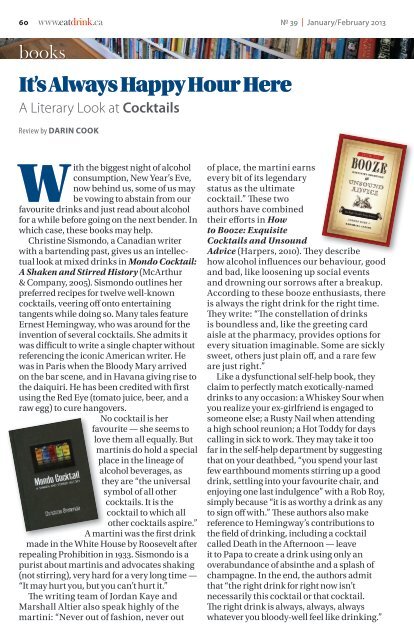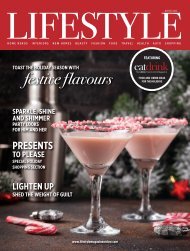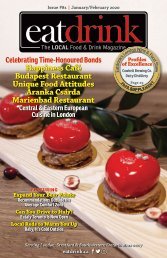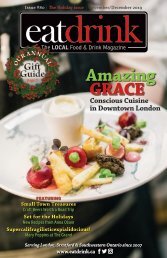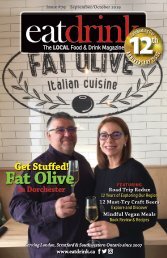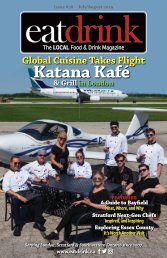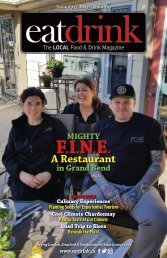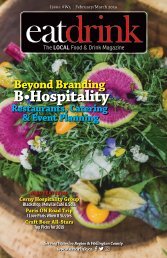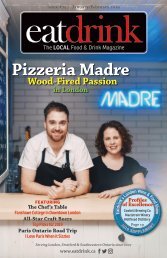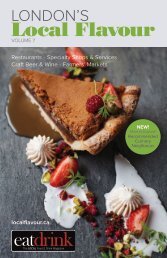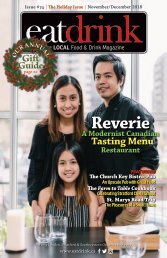Eatdrink #39 January/February 2013
The LOCAL food & drink magazine for London, Stratford & Southwestern Ontario since 2007
The LOCAL food & drink magazine for London, Stratford & Southwestern Ontario since 2007
You also want an ePaper? Increase the reach of your titles
YUMPU automatically turns print PDFs into web optimized ePapers that Google loves.
60 www.eatdrink.ca<br />
№ 39 | <strong>January</strong>/<strong>February</strong> <strong>2013</strong><br />
books<br />
It’s Always Happy Hour Here<br />
A Literary Look at Cocktails<br />
Review by Darin Cook<br />
With the biggest night of alcohol<br />
consumption, New Year’s Eve,<br />
now behind us, some of us may<br />
be vowing to abstain from our<br />
favourite drinks and just read about alcohol<br />
for a while before going on the next bender. In<br />
which case, these books may help.<br />
Christine Sismondo, a Canadian writer<br />
with a bartending past, gives us an intellectual<br />
look at mixed drinks in Mondo Cocktail:<br />
A Shaken and Stirred History (McArthur<br />
& Company, 2005). Sismondo outlines her<br />
preferred recipes for twelve well-known<br />
cocktails, veering off onto entertaining<br />
tangents while doing so. Many tales feature<br />
Ernest Hemingway, who was around for the<br />
invention of several cocktails. She admits it<br />
was difficult to write a single chapter without<br />
referencing the iconic American writer. He<br />
was in Paris when the Bloody Mary arrived<br />
on the bar scene, and in Havana giving rise to<br />
the daiquiri. He has been credited with first<br />
using the Red Eye (tomato juice, beer, and a<br />
raw egg) to cure hangovers.<br />
No cocktail is her<br />
favourite — she seems to<br />
love them all equally. But<br />
martinis do hold a special<br />
place in the lineage of<br />
alcohol beverages, as<br />
they are “the universal<br />
symbol of all other<br />
cocktails. It is the<br />
cocktail to which all<br />
other cocktails aspire.”<br />
A martini was the first drink<br />
made in the White House by Roosevelt after<br />
repealing Prohibition in 1933. Sismondo is a<br />
purist about martinis and advocates shaking<br />
(not stirring), very hard for a very long time —<br />
“It may hurt you, but you can’t hurt it.”<br />
The writing team of Jordan Kaye and<br />
Marshall Altier also speak highly of the<br />
martini: “Never out of fashion, never out<br />
of place, the martini earns<br />
every bit of its legendary<br />
status as the ultimate<br />
cocktail.” These two<br />
authors have combined<br />
their efforts in How<br />
to Booze: Exquisite<br />
Cocktails and Unsound<br />
Advice (Harpers, 2010). They describe<br />
how alcohol influences our behaviour, good<br />
and bad, like loosening up social events<br />
and drowning our sorrows after a breakup.<br />
According to these booze enthusiasts, there<br />
is always the right drink for the right time.<br />
They write: “The constellation of drinks<br />
is boundless and, like the greeting card<br />
aisle at the pharmacy, provides options for<br />
every situation imaginable. Some are sickly<br />
sweet, others just plain off, and a rare few<br />
are just right.”<br />
Like a dysfunctional self-help book, they<br />
claim to perfectly match exotically-named<br />
drinks to any occasion: a Whiskey Sour when<br />
you realize your ex-girlfriend is engaged to<br />
someone else; a Rusty Nail when attending<br />
a high school reunion; a Hot Toddy for days<br />
calling in sick to work. They may take it too<br />
far in the self-help department by suggesting<br />
that on your deathbed, “you spend your last<br />
few earthbound moments stirring up a good<br />
drink, settling into your favourite chair, and<br />
enjoying one last indulgence” with a Rob Roy,<br />
simply because “it is as worthy a drink as any<br />
to sign off with.” These authors also make<br />
reference to Hemingway’s contributions to<br />
the field of drinking, including a cocktail<br />
called Death in the Afternoon — leave<br />
it to Papa to create a drink using only an<br />
overabundance of absinthe and a splash of<br />
champagne. In the end, the authors admit<br />
that “the right drink for right now isn’t<br />
necessarily this cocktail or that cocktail.<br />
The right drink is always, always, always<br />
whatever you bloody-well feel like drinking.”


